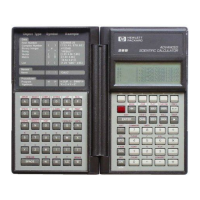Begin
the
program
with
the
program
delimiter.
DO
r-2-:----------------~1~3~3
1: 151
«I
DlIIIiWDID!lDImHIDiIIII!1ii1l
Note
that
the
cursor
changed
form
and
the
a
annunciator
appeared,
both
indicating
alpha
entry
mode.
Pressing
the
key for
any
pro-
grammable
operation
writes
the
operation's
name
in
the
command
line. Only
non-programmable
operations,
such
as pressing
[!]
to erase
a character,
are
executed.
Now
key in
the
steps you executed before.
OVER
.[]fg
r.:
2
:":":-------------------::1-=5:"71
1
ROT
.1
PURGE I
1:
«
OVER
RCL
ROT
PURGE
. .
SWAP
STO
»
.~
I STO I
DlIIIiWDID!lDImHIDiIIII!1ii1l
I ENTER I
Note
that
the
closing
delimiter»
was
added
for you.
Store
the
program
in a variable RENAME.
~
RENAME
I STO I
'-3-:
---------:1:-::3=-=3
2:
133
Check
the
USER
menu.
I USER I
1: 151
DlIIIiWDID!lDImHIDiIIII!1ii1l
3:
133
2:
133
1: 151
1mJ'jJ------
Note
that
RENAME (in abbreviated form)
appears
in
the
USER
menu.
Now
you're
ready
to execute RENAME. You'll
do
it
first
in
a
round-
about
method,
by
using
RCL,
and
then
in a
normal
method,
by
using
the
USER
menu.
The
difference
in
the
methods
highlights
the
differ-
ence
between
recalling
and
evaluating a
program
variable.
3:
Using
Variables
55

